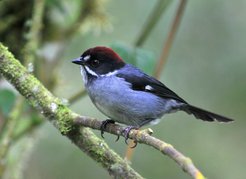Simultaneous breeding and moulting reduces fitness
Brush finches fly more slowly if they are reproducing and moulting at the same time
Moulting and breeding cost birds a lot of energy. So it would make sense for the animals to do these two things at separate times. Yet slaty brush finches (Atlapetes schistaceus) in the Colombian rainforest moult and breed at one and the same time. Scientists at the Max Planck Institute for Ornithology in Radolfzell and Princeton University therefore decided to examine whether this double burden presented evolutionary disadvantages to the tropical birds. What they found is that the wing feathers of birds that breed and moult at the same time are lighter and shorter than in birds that go through these phases consecutively. Also, their flight speed during escape flights is slower on average. This possible loss of evolutionary fitness is likely to be offset by as yet unknown positive effects.

Because feathers become continually worn down, birds regularly renew their plumage. When moulting, the flying ability of some animals can either be reduced or totally impaired, and they are less protected from the cold. Moulting also uses up a lot of energy. Birds therefore avoid other energy-intensive activities when they are moulting. So moulting and breeding usually take place separately, as they would otherwise both be competing for valuable energy reserves.
However, breeding and moulting overlap in some tropical bird species, such as some individuals in the slaty brush finch (Atlapetes schistaceus). Scientists from the Max Planck Institute for Ornithology and Princeton University therefore documented the degree of moulting and the reproductive state of these birds in Colombia on the basis of the size of their gonads and the condition of their feathers.
A comparison of feather quality revealed that moulting and reproduction do in fact compete for energy resources. "The feathers of birds that moult and breed at the same time are shorter than and almost half as heavy as those of birds that only moult. The consequence of this is smaller, less stable wings," says Maria A. Echeverry-Galvis, a colleague of Michaela Hau from the Max Planck Institute for Ornithology.
Shorter feathers and wings may have a detrimental effect on the birds' flight qualities. The ornithologists therefore measured the speed at which the birds fly off when startled. "Brush finches which are moulting and breeding at the same time fly almost 30 per cent slower than those that are only moulting or only breeding. This could make them easier for predators to catch. So simultaneous moulting and breeding means a significant loss of fitness for the brush finches," says Echeverry-Galvis.
Why some birds still moult and reproduce at the same time is something the researchers do not yet know. They suspect that unknown factors might be positively offsetting the poor quality of their feathers. Conceivably, the birds slim down when they have to transport the same weight with smaller wings – this might compensate for the loss of wing surface during moulting. "And we also discovered that brush finches that moult and breed in parallel are slightly larger on average. So maybe only big and strong individuals can handle doing both at once," says Michaela Hau.
NB/HR







